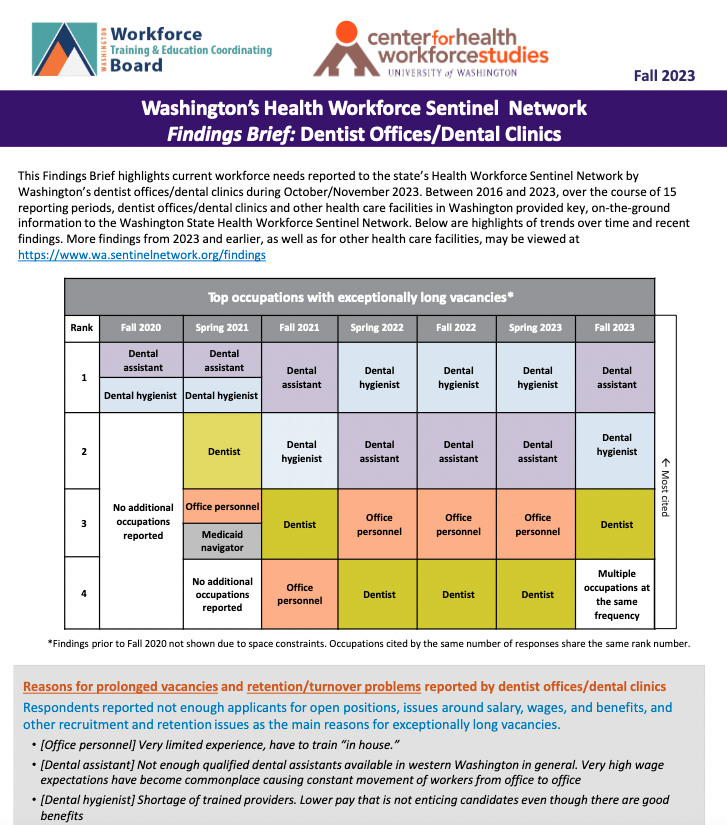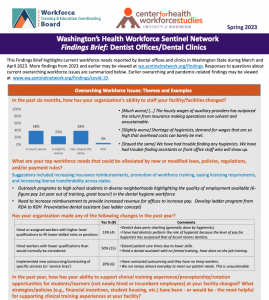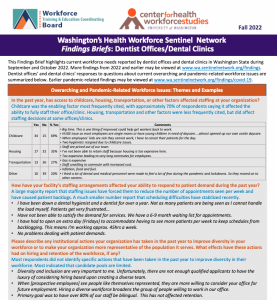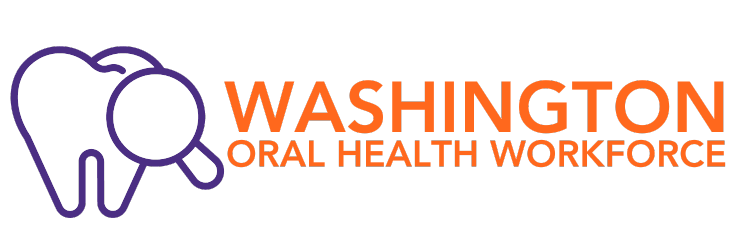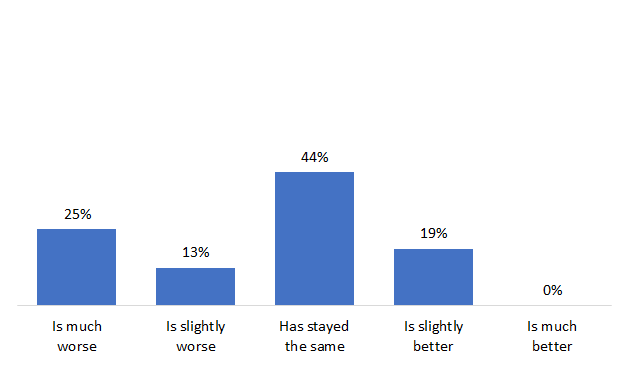Types of Dental Occupations in Highest Demand in Washington
Twice a year, oral health providers in Washington share information about their workforce needs with Washington’s Health Workforce Sentinel Network. Educators and policy makers can use this information to understand challenges related to recruitment, retention, and the employee skills that are in highest demand.
The most recent dental office and clinic findings briefs are listed below:
The table below shows the occupations that Sentinel Network respondents from dental offices and dentals clinics had the most difficulty hiring and the reasons for these exceptionally long vacancies are summarized below the table. More detailed findings from dental offices/clinics are available on our dashboard and in findings briefs linked above.
Dentists, dental hygienists and dental assistants are also employed at community health centers (CHCs), including federally qualified health centers (FQHCs). See the most recent CHC findings brief and dashboard for more details.
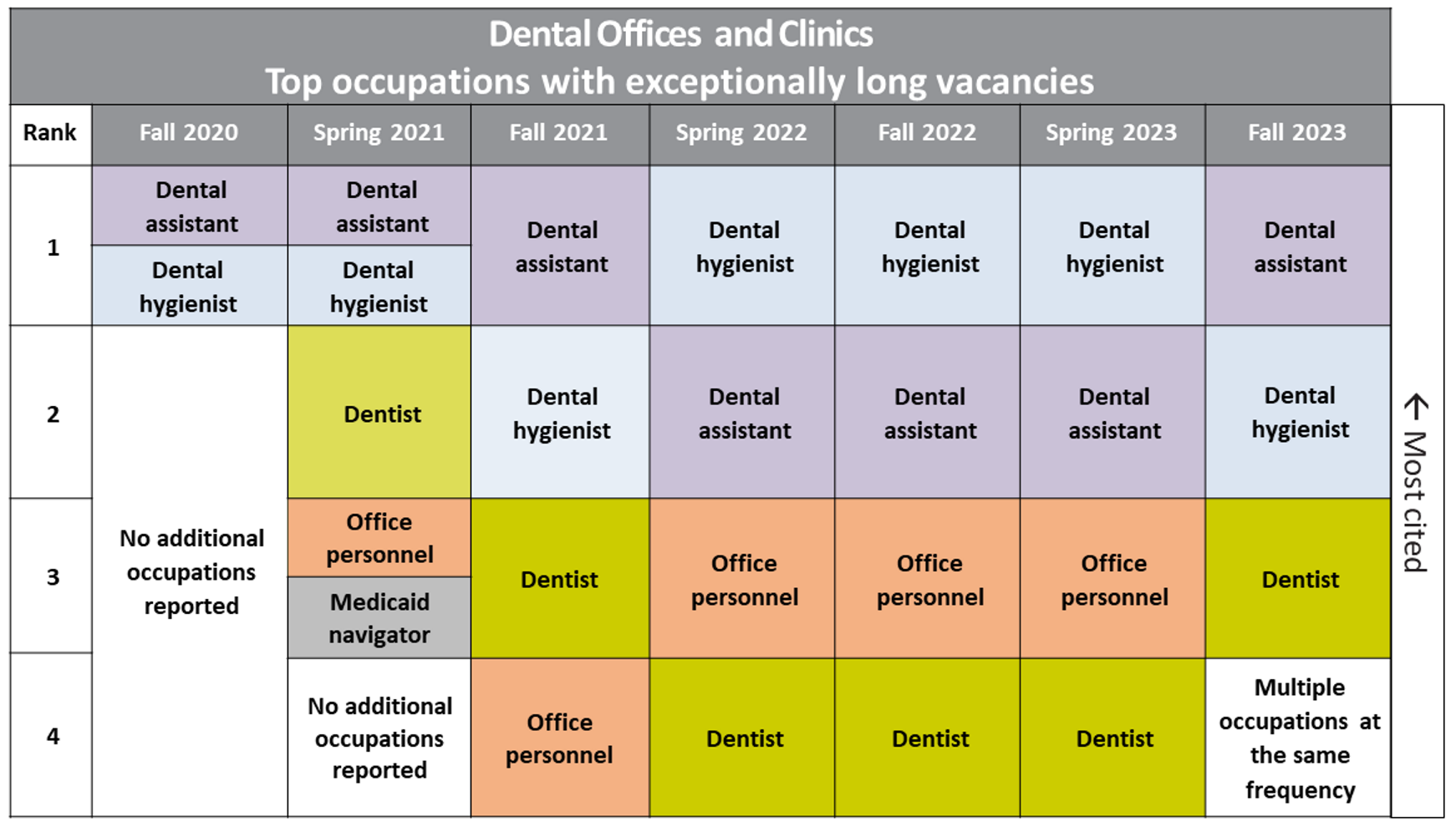
Fall 2023 Findings
Reasons for vacancies reported by Dental Offices/Clinics
Dental offices and clinics reported not enough applicants for open positions as the main reason for exceptionally long vacancies, fewer reported issues around salary, wages, and benefits, and other recruitment and retention issues.
- [Office personnel] Very limited experience, have to train “in house.”
- [Dental assistant] Not enough qualified dental assistants available in western Washington in general. Very high wage expectations have become commonplace causing constant movement of workers from office to office to the highest payers and most benefits
- [Dental assistant] Lack of interest – promote dental interest during job fairs.
- [Dental assistant] Very limited pool with limited experience. Waited due to poor candidate presentations.
- [Dental hygienist] Shortage of trained providers. Lower pay that is not enticing candidates even though there are good benefits.
- [Dental hygienist] Not enough qualified dental hygienists available in western Washington in general. Very high wage expectations have become commonplace causing constant movement of workers from office to office to the highest payers and most benefits.
- [Surgical assistant] Unable to find qualified applicants.
Dental occupations were also reported at Federally-Qualified Health Centers (FQHCs), primary care clinics, and public health organizations as having exceptionally long vacancies. These organizations cited similar struggles with filling vacancies, including shortage of qualified applicants and wage competition.
- [Dental assistant, FQHC] We have had a terrible time recruiting DA’s – candidates are sparse. We have created an in-house training program to entice applicants and it’s still tough.
- [Dental assistant, FQHC] Several candidates have stated our pay was too low. Lack of applicants.
- [Dental hygienist, FQHC] We recently filled, but it took more than a year. It has been difficult to recruit as there is a shortage of these professionals, and we are a small organization in a rural area.
- [Dentist, FQHC] Candidates have applied that are seeking NHSC loan and scholarship eligible sites however our site only has a HPSA score of 15 so does not work for these candidates as they need a score higher than that around 18. That has been very challenging for recruitment. We need a HPSA rescore.
- [Dental hygienist, Primary Care Clinic] High turnover, poorly skilled hires taking more resources and demand on staff to train. More competitive wages elsewhere.
- [Dentist, Dental hygienist, Dental assistant, Public Health Organization] We don’t have compatible wages.
To see more responses from dental offices/clinics and community health centers, visit the Sentinel Network website. Summaries of findings from dental clinics and other healthcare sectors can be found on the findings briefs page.
The Sentinel Network is an initiative of Washington’s Health Workforce Council, conducted collaboratively by Washington’s Workforce Board and the University of Washington’s Center for Health Workforce Studies. Funding to initiate the Sentinel Network came from the Healthier Washington initiative, with ongoing support from the Washington State Legislature.
Recent Strategies for Recruitment and Retention of Oral Health Workers
Fall 2023 Findings
Respondents from dental offices/clinics and community health centers (including federally qualified health centers – FQHCs) shared information with the Washington Health Workforce Sentinel Network about the recruitment and retention strategies they were using in the Fall of 2023. Many responses indicated that the traditional hiring strategies were not working for many dental providers, so they had to resort to new strategies.
What strategies has your organization used over the past 6 months to cover worker absences and fill vacancies caused by worker turnover? How successful have these strategies been?
Dental offices and clinics frequently cited salary/wage/benefits issues, reporting staff retirements, an overall shortage of new applicants, and leaving positions for higher paying jobs.
- [Dentist] Due to our location and the patient population we serve it has been hard to find qualified dentists who want to come to [this city] and to serve the populations we serve.
- [Dentist] Shift of dental employees to state employment due to pay/benefits package(s). Stagnant dental benefit and insurance company reimbursements of fees do not allow for cost of living increases commensurate with rate of inflation.
- [Dental hygienist] lots of older hygienists retired, not a lot of replacements looking to stay in our area.
- [Dental hygienist] We have lost hygienists recently while still needing more and there aren’t any applicants.
- [Dental assistant] The shortage of dental assistants is fostering an environment that incentivizes job hopping to offices with the perceived hope of higher and higher pay.
- [Dental assistant] Many assistants coming in and out. I think a lot of trainees don’t realize what is involved and how demanding dentistry is, so they don’t stay or aren’t a good fit for dentistry.
At FQHCs and primary care clinics respondents reported salary issues as a driver of turnover and retention issues, while also citing workload and patient acuity issues.
- [Dental assistant, FQHC] Low wages, dental assistants often earn wages close to the minimum wage. One critical solution would be to raise the wages for dental assistants to a level that better reflects the value of their work. Offering competitive compensation can enhance their job satisfaction and reduce the incentive to seek higher- paying positions elsewhere.
- [Dental assistant, FQHC] move to private practices after they have been trained and get experience.
- [Dentist, FQHC] Pay and stress of job when there are a number of vacancies that are difficult to fill.
- [Dentist, FQHC] Seek positions with higher compensation.
Fall 2023 Findings
A majority of Fall 2023 Health Workforce Sentinel Network respondents from dental clinics/offices and community health centers (including federally qualified health centers – FQHCs) reported that staffing issues are worse than they were six months ago.
In the past six months, how has your organization’s ability to staff your facility/facilities changed?
Example comments:
- [Much worse] It puts more stress on the staff that is employed, such as dentists doing hygiene appointments to keep up with care demands, leaving less room for patients who need restorative or emergency treatment.
- [Has stayed the same] It remains difficult to find/recruit employees.[…] We would love to hire highly qualified applicants, but their pay demand is too high for our available resources.
- [Slightly better] Dental assistant positions were filled, but hygienist needs are still unmet
How has your facility’s staffing affected your ability to respond to patient/client demand during the past year?
Recent Organizational Changes as Reported by Dental Offices/Clinics, Spring 2023
| |
%
|
Comments
|
|
Delay in care for current patients/clients
|
29%
|
- The bottleneck of reduced availability due to inadequate hygienist hours and less efficient dental assistants reduced our ability to provide care at the same pace that we used to which has resulted in delays
|
|
Reduction in the number of patients/clients you are able to care for
|
53%
|
- We can’t keep up with demand. Hygiene schedules used to be booked out six weeks, now it’s 8-9 months
- Increased stress/load on fewer existing staff. This increases the encouragement of looking for alternate employment in alternate non-healthcare fields.
|
|
No effect, operations continue as usual
|
18%
|
- We have had no trouble staffing our clinic
|
To what extent have childcare, housing, transportation, and/or workplace violence affected your ability to recruit and retain staff in the past year? What strategies has your organization used to address these challenges?
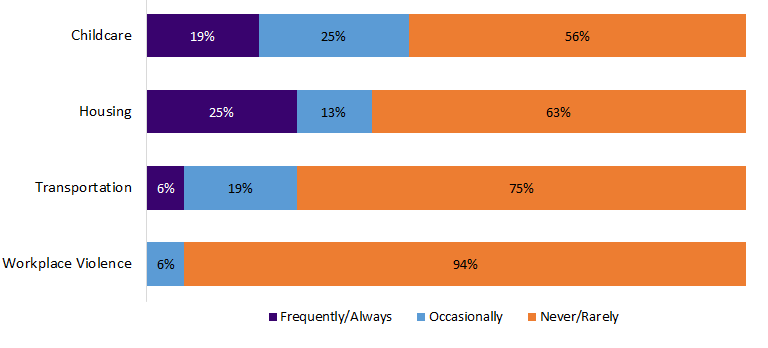
Comment examples
- As a small business, we can support but unable to provide these services.
- Strategies have failed: Increasing wages, Increasing benefits etc.
- None of these have really affected our ability to recruit and retain staff.
- Rarely, but if an employees car breaks down, we simply absorb the duties caused by their absence.
- These are challenges we cannot address.
Responses from Dental Offices, Dental Clinics, and Community Health Centers
Twice a year, oral health providers in Washington share information about their workforce needs with Washington’s Health Workforce Sentinel Network. Educators and policy makers can use this information to understand challenges related to recruitment, retention, and the employee skills that are in highest demand.
The dashboard below shows responses from Sentinel Network respondents at dental offices, dentals clinics, and community health centers (CHCs, including federally qualified health centers – FQHCs).
